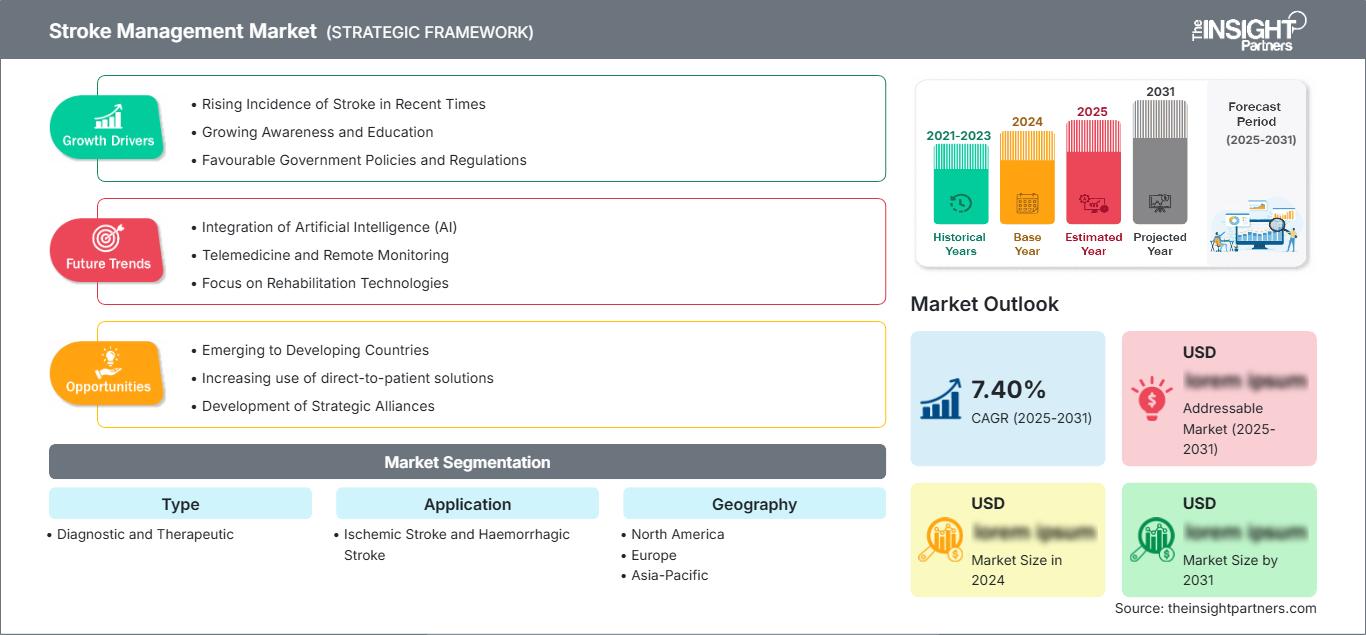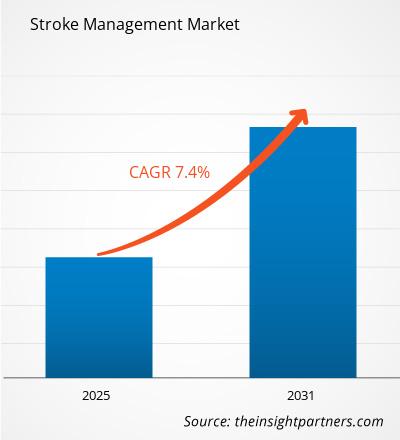Se espera que el tamaño del mercado de gestión de accidentes cerebrovasculares alcance los US$ 71.1 mil millones para 2031. Se anticipa que el mercado registre una CAGR del 7,0% durante 2025-2031.
El informe presenta un análisis por tipo (diagnóstico y terapéutico). Además, proporciona un análisis por aplicación (ictus isquémico y hemorrágico). El análisis global se desglosa a nivel regional y por países principales. El alcance abarca el tamaño del mercado y las previsiones a nivel global, regional y nacional para todos los segmentos clave. El informe ofrece el valor en USD de los análisis y segmentos mencionados. El informe proporciona estadísticas clave sobre la situación del mercado de los principales actores y presenta tendencias y oportunidades.
Propósito del Informe
El informe "Mercado de Gestión de Accidentes Cerebrovasculares" de The Insight Partners busca describir el panorama actual y el crecimiento futuro, los principales factores impulsores, los desafíos y las oportunidades. Esto proporcionará información a diversas partes interesadas del negocio, como:
- Proveedores/fabricantes de tecnología: Para comprender la dinámica cambiante del mercado y conocer las oportunidades potenciales de crecimiento, lo que les permitirá tomar decisiones estratégicas informadas.
- Inversores: Realizar un análisis exhaustivo de tendencias respecto a la tasa de crecimiento del mercado, las proyecciones financieras del mercado y las oportunidades que existen en toda la cadena de valor.
- Órganos reguladores: Regular las políticas y las actividades policiales en el mercado con el objetivo de minimizar el abuso, preservar la confianza de los inversores y defender la integridad y estabilidad del mercado.
Segmentación del mercado de gestión de accidentes cerebrovasculares
- Diagnóstico y terapéutico
Solicitud
- Accidente cerebrovascular isquémico y accidente cerebrovascular hemorrágico
Obtendrá personalización en cualquier informe, sin cargo, incluidas partes de este informe o análisis a nivel de país, paquete de datos de Excel, así como también grandes ofertas y descuentos para empresas emergentes y universidades.
Mercado de gestión de accidentes cerebrovasculares: perspectivas estratégicas

-
Obtenga las principales tendencias clave del mercado de este informe.Esta muestra GRATUITA incluirá análisis de datos, desde tendencias del mercado hasta estimaciones y pronósticos.
Factores que impulsan el crecimiento del mercado de la gestión de accidentes cerebrovasculares
- Aumento de la incidencia de accidentes cerebrovasculares en los últimos tiempos: El aumento del número de casos de accidentes cerebrovasculares y de las discapacidades asociadas es un factor clave en el mercado. Con el envejecimiento de la población y los factores relacionados con los cambios en el estilo de vida asociados a las preocupaciones sanitarias, la necesidad de incorporar soluciones eficaces para el manejo de los accidentes cerebrovasculares es cada vez mayor.
- Mayor concienciación y educación: Cada vez más personas comprenden los síntomas del ictus y la importancia de actuar con prontitud. La participación del público en campañas de salud y la educación sobre la enfermedad les permite buscar tratamiento más rápidamente, lo cual es fundamental para garantizar una mejor recuperación.
- Políticas y regulaciones gubernamentales favorables: Se fomentan las inversiones y los nuevos avances en el mercado ya que varias autoridades han permitido el desarrollo de terapias y tecnologías utilizadas en el manejo de pacientes con accidente cerebrovascular.
Tendencias futuras del mercado de gestión de accidentes cerebrovasculares
- Integración de la Inteligencia Artificial (IA): La IA es útil para el diagnóstico del ictus y la formulación del plan de tratamiento adecuado. Algoritmos sofisticados son capaces de evaluar imágenes y pronosticar el pronóstico de un paciente determinado, optimizando así su manejo. Los proveedores de dispositivos que utilizan la tecnología de IA tienen mayores posibilidades de ganarse la confianza de los profesionales sanitarios, especialmente en la prestación de diagnósticos y tratamientos.
-
Telemedicina y Monitoreo Remoto: La telemedicina está revolucionando las prácticas de atención del ictus al brindar la posibilidad de consultas y seguimiento a distancia. Esta tendencia facilita intervenciones y tratamientos rápidos. Alcance del informe.
Perspectivas regionales del mercado de gestión de accidentes cerebrovasculares
Los analistas de The Insight Partners han explicado detalladamente las tendencias regionales y los factores que influyen en el mercado de la gestión del ictus durante el período de pronóstico. Esta sección también analiza los segmentos y la geografía del mercado de la gestión del ictus en Norteamérica, Europa, Asia Pacífico, Oriente Medio y África, y Sudamérica y Centroamérica.
Alcance del informe de mercado sobre el manejo de accidentes cerebrovasculares
EuropaPor aplicación- Accidente cerebrovascular isquémico y accidente cerebrovascular hemorrágico
- Reino Unido
- Alemania
- Francia
- Rusia
- Italia
- Resto de Europa
- Porcelana
- India
- Japón
- Australia
- Resto de Asia-Pacífico
- Brasil
- Argentina
- Resto de América del Sur y Central
- Sudáfrica
- Arabia Saudita
- Emiratos Árabes Unidos
- Resto de Oriente Medio y África
Atributo del informe Detalles Tamaño del mercado en 2024 XX mil millones de dólares estadounidenses Tamaño del mercado en 2031 71.100 millones de dólares estadounidenses CAGR global (2025-2031) 7.0% Datos históricos 2021-2023 Período de pronóstico 2025-2031 Segmentos cubiertos Por tipo - Diagnóstico y terapéutico
Regiones y países cubiertos América del norte - A NOSOTROS
- Canadá
- México
Líderes del mercado y perfiles de empresas clave - Laboratorios Abbott
- B Braun Melsungen AG
- Boston Scientific Corp.
- Bristol-Myers Squibb
- Salud del cardenal
- Medtronic Plc.
- GlaxoSmithKline Plc.
- GE Healthcare
- Merck
Densidad de actores del mercado de gestión de accidentes cerebrovasculares: comprensión de su impacto en la dinámica empresarial
El mercado de la gestión del ictus está creciendo rápidamente, impulsado por la creciente demanda del usuario final debido a factores como la evolución de las preferencias del consumidor, los avances tecnológicos y un mayor conocimiento de los beneficios del producto. A medida que aumenta la demanda, las empresas amplían su oferta, innovan para satisfacer las necesidades del consumidor y aprovechan las tendencias emergentes, lo que impulsa aún más el crecimiento del mercado.

- Obtenga una descripción general de los principales actores clave del mercado de gestión de accidentes cerebrovasculares
- Análisis histórico (2 años), año base, pronóstico (7 años) con CAGR
- Análisis PEST y FODA
- Tamaño del mercado, valor/volumen: global, regional y nacional
- Industria y panorama competitivo
- Conjunto de datos de Excel
Informes recientes
Informes relacionados
Testimonios
Razón para comprar
- Toma de decisiones informada
- Comprensión de la dinámica del mercado
- Análisis competitivo
- Información sobre clientes
- Pronósticos del mercado
- Mitigación de riesgos
- Planificación estratégica
- Justificación de la inversión
- Identificación de mercados emergentes
- Mejora de las estrategias de marketing
- Impulso de la eficiencia operativa
- Alineación con las tendencias regulatorias






















 Obtenga una muestra gratuita para - Mercado de gestión de accidentes cerebrovasculares
Obtenga una muestra gratuita para - Mercado de gestión de accidentes cerebrovasculares